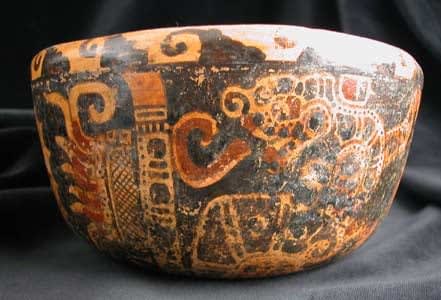Mayan Polychrome Bowl, 500 CE - 900 CE
Terracotta
6 x 3.25
PF.6010
Further images
The Ancient Maya were undoubtedly the masters of ceramics in Mesoamerica. Few cultures anywhere in the world can compare to the level of sophisticated artistry of the paintings and elegant...
The Ancient Maya were undoubtedly the masters of ceramics in Mesoamerica. Few cultures anywhere in the world can compare to the level of sophisticated artistry of the paintings and elegant forms of the pottery that the Maya achieved. However, when one considers that all Mayan vessels were created without the aid of a potter’s wheel, their achievement becomes even that much more stunning. This vessel is a perfect example of Mayan ceramics. When we hold the bowl in our hands, we feel the subtle bumps and indentations that are the telltale signs of handcraftsmanship. While the interior rim of the vessel has been adorned with two black bands, the majority of the exterior has been painted black. However, the painter utilized the natural orange hue of the clay to create stunning reserve designs, much like the Ancient Greeks. A spotted black panther, with red highlights, crouches on his hind, tongue curling outwards as he looks backward, front paw held in the air. While this panther motif has been repeated twice, the spaces between them have been filled by a large black circle framed by a reserve orange circle with scalloped edges. Perhaps this represents an eclipse with the rays of the sun peeking out from behind the blocked sun? Surely the Mayan, master of astronomy that they were, must have been fascinated by this natural phenomenon. While this vessel appears to be a beautiful example of functional pottery, there was a greater purpose for this bowl than the transportation and containment of precious liquids. Discovered in a tomb, buried alongside a deceased ruler or high-ranking dignitary, this vase was as essential in the afterlife as it was in our world.







